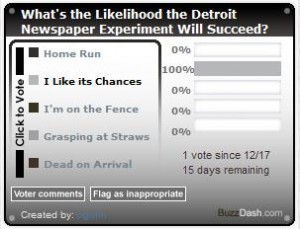 The pending purchase of the San Diego Union-Tribune by a private equity firm opens an interesting new chapter in the newspaper industry’s history. Not much is known about Platinum Equity other than the company has completed more than 100 acquisitions in the last 15 years and one of its partners is a successful newspaper owner. For a company that has spent $27.5 billion on acquisitions, it’s website is almost defiantly sparse, as if to reinforce that it doesn’t have to tell anybody anything it doesn’t want to.
The pending purchase of the San Diego Union-Tribune by a private equity firm opens an interesting new chapter in the newspaper industry’s history. Not much is known about Platinum Equity other than the company has completed more than 100 acquisitions in the last 15 years and one of its partners is a successful newspaper owner. For a company that has spent $27.5 billion on acquisitions, it’s website is almost defiantly sparse, as if to reinforce that it doesn’t have to tell anybody anything it doesn’t want to.
Based on our experience with similar takeovers in the past, here’s a short FAQ of what we think you can expect. Also be sure to check out Alan Mutter’s analysis for the views of a professional investor.
What’s a private equity firm?
It’s basically a group of rich people who pool their money and invest in companies that they think are undervalued. They bring their expertise to bear to quickly grow the value of the assets they acquire and then sell them, hopefully at a substantial profit. There are a lot of private equity companies out there, but you don’t hear much about them because they prefer to work in the background and they’re largely unregulated.
Why did this one buy the Union-Tribune?
For starters, it probably got a great price. Private equity firms look to unlock asset value and Platinum Equity must believe that it can quickly make changes that will substantially increase the value of the paper. What those changes are is still unknown. Because private equity firms don’t have to tap into the lending market to any great degree, they are among the few institutions that are capitalized to make big purchases right now. That’s another reason we can presume they got a great price.
Platinum Equity would not have bought the Union-Tribune unless the partners believed that the business was undervalued. That’s another indication that perhaps the market has hit bottom. The big question is what changes the partners believe they have to make to increase the value of the asset. That’s going to be the really interesting question
So what’s going to happen now?
In the short term, not much. The new owners will spend the next couple of months on paperwork to get the deal done. However, things are likely to happen pretty quickly after that.
The partners in these private equity firms are usually decisive, no-nonsense people who don’t fear making tough decisions. It’s likely there will be downsizing and probably a lot of it since the new owners don’t have the sentimental attachments of the current owners. One thing is for sure: the new owners will treat the Union-Tribune as a business and probably a short-term business at that. Professional investment firms rarely work on timelines of more than three to five years. If they haven’t sold the business and doubled their money by that time, the deal is considered a failure
Is this good for the Union-Tribune?
It probably is. Platinum Equity spokesman Louis Samson said the right things in endorsing the value of the Union-Tribune brand: “We will bring a strong operational focus that helps ensure the Union-Tribune not only survives in this market, but thrives.” This is good news, because professional investors are as likely carve up and destroy a company as readily as they can build one. It appears that the new owners are focused on stabilizing and supporting the brand, but that doesn’t mean they will avoid hard decisions. It should be noted, by the way, that the company’s press release about the acquisition makes no reference to continuing the Union-Tribune s as a newspaper
Is this good for the newspaper industry?
Yes, because it is one sign that the market has become attractive again. With the exception of a few small papers in Connecticut, nobody has bought a major newspaper in over a year. The fact that someone finally did buy one may open the door for other investors to come forward.
Platinum Equity’s moves certainly will be closely watched. It will also be interesting to see how a professional investment firm treats its new asset. While Platinum Equity has some experience in the market in the person of partner David Black, it is not a professional publisher. The partners will be looking at the Union-Tribune as an asset and trying to maximize the value of the asset. In other words, their minds won’t be clouded by assumptions of what a newspaper should be. It will be just a business to them. Since the problems in the newspaper industry are fundamentally business problems, it will be interesting to watch what a professional management firm does to solve them.
What would you do if you were an employee of the Union-Tribune right now?
I’d think hard about how to justify my value to the organization, not in terms of my length of service or number of awards but rather relative to the company’s bottom line. When business managers with no newspaper background took over at Tribune Co., they started measuring journalist productivity by column inches of copy. The new owners at the Union-Tribune probably aren’t that dense, but they will almost certainly take a financial analyst’s approach to managing the operation. Employees who can’t demonstrate why they are critical to the business will be most at risk, as will those who carry the highest salaries.

 Nigeria’s Vanguard newspaper reported matter-of-factly that police in Lagos implicated a goat (left, although not the actual goat in custody) in an attempted auto theft, saying that one of the thieves transformed himself into the animal in an attempt to avoid arrest. The thief was apprehended nonetheless, and now will either have to change back to a person or a spend the rest of his life in the, um, pen. If you don’t believe us, this story
Nigeria’s Vanguard newspaper reported matter-of-factly that police in Lagos implicated a goat (left, although not the actual goat in custody) in an attempted auto theft, saying that one of the thieves transformed himself into the animal in an attempt to avoid arrest. The thief was apprehended nonetheless, and now will either have to change back to a person or a spend the rest of his life in the, um, pen. If you don’t believe us, this story  Editors at the Wine Spectator
Editors at the Wine Spectator 




